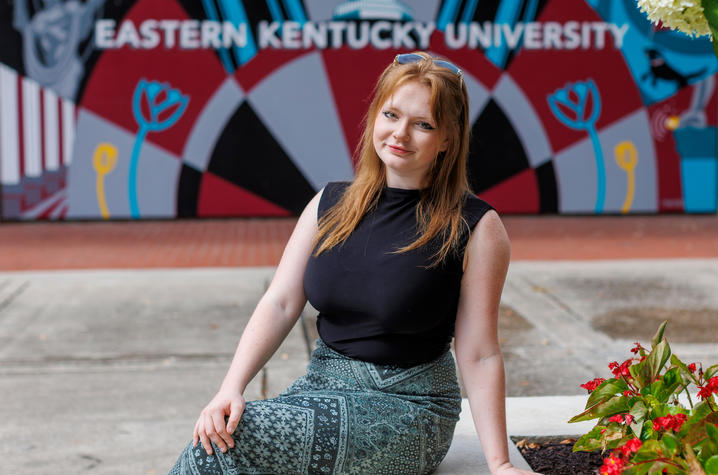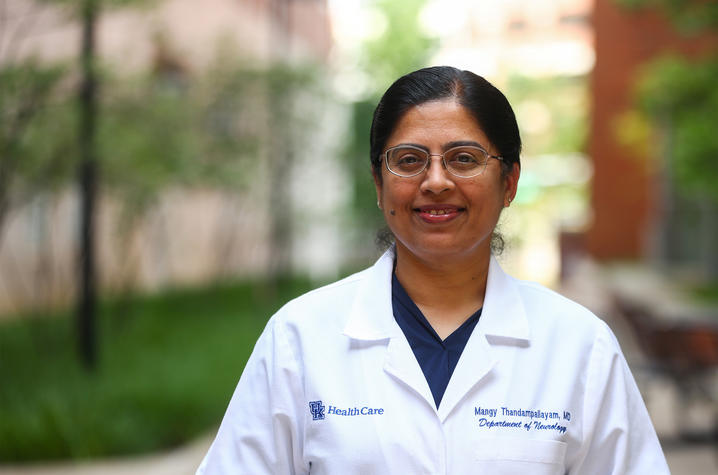UK physicians restore college student’s vision after ‘false brain tumor’
LEXINGTON, Ky. (Aug. 12, 2024) – “I began having a headache.” That headache was the start of a path the Eastern Kentucky University student Madison Carlisle never imagined her semester would take.
“It was the week before fall break. My vision was starting to act up, there were times it was like I was seeing two of everything,” Carlisle said. “I thought it was likely a migraine and if I went to the doctor they would say the same thing. So, I took some medicine and I was really just trying to power through and get all my school work done before the break.”
*****
Home in Frankfort for fall break after completing her assignments and classes, Carlisle was looking forward to a few days away and gearing up for the rest of the semester.
However, the headache she arrived home with was unrelenting, and her vision continued to worsen. The college student decided to go to her eye doctor to get checked out. Through imaging there, they could tell her optic nerve was swollen, and they encouraged her to go to the local emergency department.
While there, Carlisle underwent a spinal tap and her vision returned to normal … at least for a few hours.
“Shortly after that I began getting sick. I couldn’t keep anything down,” she said. “Then my vision started getting worse again. They then directed us to get to UK. So, within two days of me getting my spinal tap, I was headed to Lexington.”
The team at the University of Kentucky Albert B. Chandler Hospital Emergency Department assessed Carlisle and checked her spinal tap site for infection. They determined she needed to be seen by neuro-ophthalmology and sent her home with some medication until her appointment with a specialist.
“I looked at the referral and saw that there was a mention of this condition called idiopathic intracranial hypertension,” said Mangayarkarasi Thandampallayam, M.D., a neuro-ophthalmologist with UK HealthCare’s Kentucky Neuroscience Institute.
Idiopathic intracranial hypertension (IIH) is a condition caused by an excess of cerebrospinal fluid building up in the skull and creating pressure. Also known as a pseudotumor cerebri – which literally translates to “false brain tumor.” Carlisle had what is known as fulminant IIH (FIH), a subtype of IIH that occurs in 2-3% of patients with IIH and results in severe, rapidly progressive vision loss within one month symptoms starting. Patients like Carlisle are at a high risk for permanent vision loss and require prompt medical diagnosis and treatment.
“We always check what the pressure is inside the brain,” said Thandampallayam. “I saw the number was 54, and normally it should be less than 25. So when I saw this number double, I knew we needed to get her in quickly.”
At this point fall break was over for Carlisle. The extremely driven college student had concerns with missing class and taking time away from her school work. Dr. Thandampallayam stressed the urgent need for her to be seen again and receive treatment for her condition right away.
“With her vision already deteriorating, she could go blind. But that obviously is something that a healthy college age person is not really thinking about or fully understands. The threat that she might lose vision for her entire life was real,” said Thandampallayam.
In a matter of days, Carlisle made the trip back to Lexington and was admitted.
Due to the severity of the swelling and impending vision loss, she needed more than medication and her condition required a multidisciplinary team effort which included Dr. Thandampallayam, neurologists, neurosurgeons, OB-GYNs and oculoplastic surgeon Peter Timoney, M.D.
“Dr. Timoney agreed to perform a procedure known as an optic nerve sheath fenestration, where they make a small cut that releases the pressure on the optic nerve,” said Thandampallayam. “The decompression was needed as her optic nerve looked like as if somebody was strangulating it and it was affecting the blood circulation of the optic nerve.”
In addition to that procedure on both eyes, Carlisle required a few other interventions by the multidisciplinary team assembled in an effort to save her vision. Zain Guduru, M.D., was the neurologist on service when she was admitted to the hospital.
“He really acted swiftly and worked closely with the neurosurgery team to get the lumbar drain underway while waiting for the optic nerve sheath fenestration,” said Thandampallayam.
Most people with IIH are treated with medications and weight loss. Fewer than 1 out of 10 people with IIH will require surgical treatment. Surgery is needed if medical treatment and weight loss do not stop the visual loss. Carlisle was having rapid vision loss due to high pressure from the circulating cerebrospinal fluid.
Justin Fraser, M.D., director of Cerebrovascular Surgery and Neuro-Interventional Radiology was out of town at the time, but due to the serious threat of blindness he communicated with the rest of the neurosurgery team and chief residents giving them the green light to go ahead with the procedure under the guidance of Farhan Mirza, M.D., and Shivani Pahwa, M.D.
The team successfully placed the lumbar drain to relieve the pressure and kept it in for two days. This was the first time the procedure was performed at UK HealthCare for this particular condition. The following day, Carlisle noticed a significant improvement in her vision.
“The neurosurgery team and the rest of us were thrilled at the improvement. We were making progress,” said Thandampallayam.
Adding another layer to the urgent situation was the birth control implant in Carlisle’s arm.
“That type of birth control can contribute to this condition. Over the weekend, we were able to get the gynecology team in to remove the implant,” said Thandampallayam. “It all came together in an amazing way. For a stroke patient we often say, ‘time is brain;’ we have a similar mindset when it comes to this condition, ‘time is vision.’ If we act urgently, we often can save the patient’s vision.”
With the lumbar drain and removal of the implant, Carlisle’s vision stabilized, and she was able to undergo the optic nerve sheath fenestration. Then the recovery process started … which did result in the 19-year-old having to withdraw from all her classes that fall semester. However, even considering all she went through beginning in October, Carlisle was able to start the spring semester as scheduled.
“I still have some slight issues peripherally and some scar tissue, but I was cleared to drive and return to normal activities … which is amazing,” said Carlisle.
Despite the setback, Carlisle finished the school year strong and has not let up through the summer. The psychology major is working two jobs, including an internship with the state at the Cabinet for Health and Family Services.
“I was really moved by Madison,” said Thandampallayam. “She was very dedicated to her education and was also working a part-time job at that time. In that moment, though, she was forced to face the reality of life without her vision. Thanks to all of our experts who really helped save her vision and give her life back.”
IIH is relatively common in Kentucky, particularly in young females who are overweight. While it can cause headaches and vision loss over time, it is extremely rare for it to cause rapid vision loss like what Carlisle experienced. Birth control hormones have been linked to the condition, although it is rare.
Dr. Thandampallayam was driven to act urgently based on an experience during her fellowship.
“I saw a similar patient and she was also in her 20s. She was the mother of a young child and really had a lasting impact on me. Her optic nerve had already atrophied and there was no way we could save her vision. Thankfully, for Carlisle, we saw her at just the right time,” said Thandampallayam. “We are so fortunate to have everyone here in one place. This was the epitome of a team effort. Special thanks to my neuro-ophthalmology colleague Dr. Sudhakar, dedicated neurology residents, neurosurgery residents and the entire team involved with the care of Madison.”
Thanks to the team effort, Carlisle can once again clearly see the goals she has set along her educational journey.
“I’m aiming to get my doctorate in psychology. I want to be a child and family psychologist,” she said. “It is a while from now, but that is the hope and the want. I’m thankful to be back on the road to achieving that.”
UK HealthCare is the hospitals and clinics of the University of Kentucky. But it is so much more. It is more than 10,000 dedicated health care professionals committed to providing advanced subspecialty care for the most critically injured and ill patients from the Commonwealth and beyond. It also is the home of the state’s only National Cancer Institute (NCI)-designated Comprehensive Cancer Center, a Level IV Neonatal Intensive Care Unit that cares for the tiniest and sickest newborns and the region’s only Level 1 trauma center.
As an academic research institution, we are continuously pursuing the next generation of cures, treatments, protocols and policies. Our discoveries have the potential to change what’s medically possible within our lifetimes. Our educators and thought leaders are transforming the health care landscape as our six health professions colleges teach the next generation of doctors, nurses, pharmacists and other health care professionals, spreading the highest standards of care. UK HealthCare is the power of advanced medicine committed to creating a healthier Kentucky, now and for generations to come.







